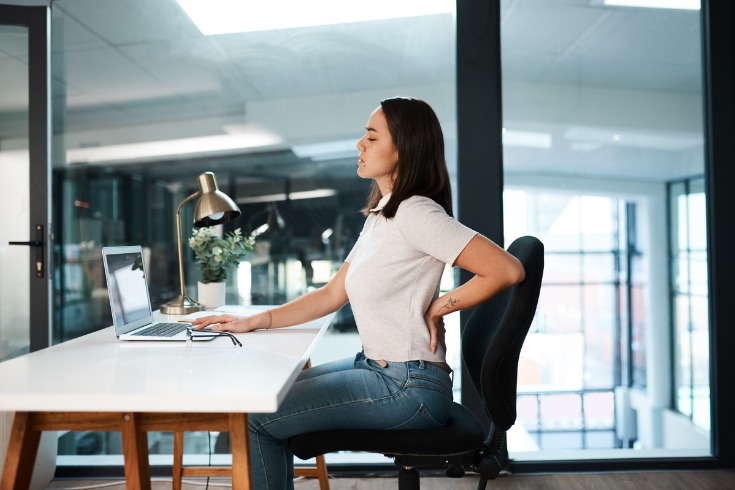
Is sitting really the new smoking? We look at what science tells us about our sedentary jobs and what we can do to improve them.
What we know is that sitting and lying down during the day can lead to an increased risk of Type 2 diabetes, being overweight, depression, anxiety and premature death.
What Are The Effects of Sitting for Long Periods?
The human body is designed to stand upright. Its cardiovascular system and bowel are more efficient when upright. Muscle movement helps the body digest fats and sugars and keeps metabolic syndrome at bay. The risk of lung, uterine and colon cancers increase with sitting rates.
Leg and gluteal muscles are at risk of weakness and injury from too much sitting. The hip flexor muscles shorten, leading to hip joint problems. Varicose veins and deep vein thrombosis (DVT) are also more likely.
A life-size doll named Emma was created to show how future office workers could look after working for years at a poorly designed workstation. The doll has a permanently hunched back, protruding stomach, varicose veins and red eyes caused by sitting in front of a computer screen. They designed the doll following a study of 3,000 office workers (1,000 each from France, Germany and the UK) that found almost half complained of sore eyes, a sore back and headaches caused by their work space.
Research Into Sitting For Prolonged Periods
Data from 222,000 Australians aged 45 years and older found death rates peak for those people who spend 11 hours or more sitting every day. The death risk is 15% higher for those people who sit between eight and 11 hours compared to sitting for less than four hours per day. Prolonged sitting is a risk factor for all-cause mortality.
Australia’s Physical Activity and Sedentary Behaviour Guidelines point out that even when a person does enough physical activity to meet the guidelines we can still consider them sedentary because they sit or lie down for long periods at work or home.
The guidelines recommend adults aged 18-64 do 150-300 minutes (2.5 to 5 hours) of moderate-intensity physical activity or 75 to 150 minutes of vigorous physical activity every week (or a combination of the two). Muscle strengthening exercise is needed every two days. Adults should minimise the time in prolonged sitting positions and break up sitting as often as possible.
Almost 70% of Australians are classified as sedentary or having low levels of physical activity. The recommended exercise rate is 30 minutes of moderate-intensity physical activity for adults and 60 minutes for children.
How To Reduce the Amount of Time Spent Sitting
Many people blame their health problems on the long hours spent sitting at work. While sedentary work has a big impact on the number of hours spent sitting, some people forget about the incidental sitting they do in the car, on public transport and on the lounge. It’s important to look for alternatives to sitting at both work and outside work.
Sit Stand Desks
Research tells us the most healthy way to work in an office is to alternate between sitting and standing throughout the day to reduce the number of sitting hours.
Sit stand desks have become popular in recent years, but what is the research telling us about their effectiveness? There are still conflicting opinions on the topic. A review of 53 studies into sit stand desks found much of the research was carried out on young workers who are a healthy weight using the sit stand desk for a short period. We need more research on overweight, older workers to analyse if there are cardiovascular or muscle benefits.
Tips for Reducing Sedentary Time at Work
The time we spend in sedentary work increases our chance of health problems. Try to break up the time you spend sitting with these tips:
- Set a timer to remind you to get up and walk around
- Park the car or hop off public transport so you walk further to get to and from work
- Organise walking meetings
- Leave the office at lunchtime and do some exercise
- Take the stairs instead of the lift
- Use a printer further away from your desk
- Visit colleagues rather than picking up the phone or using email
- Set a timer to remind you to get up from your computer regularly
Tips for Reducing Sedentary Activity During Personal Time
Most adults spend 90% of their leisure time sitting down. By swapping some sedentary activities for more physically active ones or just changing the way you do some activities, you can increase your amount of movement.
Try a few of these ideas:
- Limit your television time
- When you are watching TV stand and do jobs like ironing or tidying the house
- Go outside and do some gardening
- Be conscious of how much time you sit on the lounge during the day
- Use audio books and move around while you listen
- Stand while on public transport instead of sitting
- Catch up with friends while exercising rather than at a café
While the hours spent sitting at work are harmful, it’s all the little incidental leisure time you spend sitting that adds up to a sedentary life. By making plenty of slight changes, you can increase the amount of physical activity you do and reduce your health risks.
If your organisation would like to know more about our Exercise or Nutrition Support program, call PeopleSense by Altius on 1300 307 912 or contact us online.